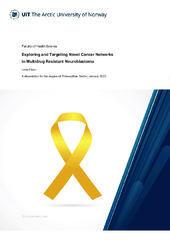| dc.contributor.advisor | Einvik, Christer | |
| dc.contributor.author | Olsen, Lotte | |
| dc.date.accessioned | 2020-06-09T08:56:40Z | |
| dc.date.available | 2020-06-09T08:56:40Z | |
| dc.date.issued | 2020-06-19 | |
| dc.description.abstract | High-risk neuroblastoma has an overall survival of only 50%, and alternative treatment options for this patient group are needed. In this thesis, I will present novel insight into potential anti-tumor mechanisms for high-risk neuroblastoma. Firstly, our investigations have revealed a tumor suppressor function of the microRNA (miRNA) <i>miR-323a-3p</i> in neuroblastoma cells, and that this miRNA directly targets the oncogene STAT3. Secondly, we have shown that upregulation of another miRNA, <i>miR-193b-3p</i>, made neuroblastoma cells with a primary dependence on the anti-apoptotic protein MCL-1 more sensitive to the BH3 mimetic ABT-737. Lastly, we have tested the ribosome biogenesis inhibitors CX-5461 and quarfloxin in neuroblastoma and found that they effectively inhibit growth in neuroblastoma cells with MYCN amplification, an aberration that is commonly found in high-risk neuroblastoma. These inhibitors reduced levels of MYCN protein and caused DNA damage, G2-cell cycle arrest and apoptosis in neuroblastoma cells. Furthermore, we have demonstrated that they reduce tumor growth in murine neuroblastoma xenograft models. The most profound anti-tumor effects of CX-5461 and quarfloxin were observed in cells and tumors with MYCN amplification and a functional p53 protein, a combination that is often found in high-risk neuroblastoma. | en_US |
| dc.description.doctoraltype | ph.d. | en_US |
| dc.description.popularabstract | The childhood cancer, neuroblastoma, is the most common cancer in infants. The last decades, therapy improvement has led to an increase in overall survival for the children afflicted by this cancer. Unfortunately, among the ones that have the most harmful stage of this disease only about 50% survive. We still have to find treatments that are more effective, in order to battle this cancer; both to save lives and to prevent short- and long-term adverse effects that come from intensive treatment. This thesis will show how specific alterations done to neuroblastoma cells can reduce the cancer cells’ growth and eventually kill them.
First, we studied microRNAs, small RNA molecules that can regulate other RNAs. We demonstrated that a microRNA called miR-323a-3p reduced the number of healthy, living cells when it stopped cells from dividing (cell cycle arrest) and caused programmed cell death (apoptosis). We also showed that a second microRNA, called miR-193b-3p, made neuroblastoma cells more susceptible to be killed by a drug called ABT-737. When we combined treatment with miR-193b-3p and ABT-737 in a specific type of neuroblastoma cells, it killed the cells more successfully than treatment with either alone.
Secondly, we tested two drugs, called CX-5461 and quarfloxin, and demonstrated that they could effectively kill neuroblastoma cells with several copies of the MYCN gene (MYCN amplification). This abnormality is often found in neuroblastoma, and gives the patient a worse prognosis. Both CX-5461 and quarfloxin reduced the levels of the MYCN protein, damaged the DNA within the cancer cells and led cells into programmed cell death. We also showed that the drugs reduced growth of cancer tumors in mice.
Collectively, this thesis presents possible new ways of treating neuroblastoma cancer in children, either by using microRNAs alone or in combination with other drugs, or by using the drugs CX-5461 or quarfloxin. | en_US |
| dc.description.sponsorship | UiT The Arctic University of Tromsø, The Northern-Norwegian Health Authorities (Helse Nord), The University Hospital of North Norway (UNN), Barnekreftforeningen and Simon Fougner Hartmanns Familiefond funded this PhD project. | en_US |
| dc.identifier.isbn | 978-82-7589-679-5 | |
| dc.identifier.uri | https://hdl.handle.net/10037/18495 | |
| dc.language.iso | eng | en_US |
| dc.publisher | UiT The Arctic University of Norway | en_US |
| dc.publisher | UiT Norges arktiske universitet | en_US |
| dc.relation.haspart | <p>Manuscript I: Bhavsar, S.P., Olsen, L., Løkke, C., Flægstad, T. & Einvik, C. Hsa-miR-323a-3p Functions as a Tumor Suppressor and Targets STAT3 in Neuroblastoma Cells. (Manuscript).
<p>Manuscript II: Olsen, L., Roth, S.A., Løkke, C., Bhavsar, S.P., Flægstad, T. & Einvik, C. Hsa-miR-193b-3p Sensitizes MCL-1 Primed Neuroblastoma Cell Lines to the BH3 Mimetic ABT-737. (Manuscript).
<p>Paper I: Hald, Ø.H., Olsen, L., Gallo-Oller, G., Elfman, L.H.M., Løkke, C., Kogner, P, … Einvik, C. (2019). Inhibitors of Ribosome Biogenesis Repress the Growth of MYCN-amplified Neuroblastoma. <i>Oncogene, 38</i>(15), 2800-2813. Also available in Munin at <a href=https://hdl.handle.net/10037/18268>https://hdl.handle.net/10037/18268</a>. | en_US |
| dc.rights.accessRights | openAccess | en_US |
| dc.rights.holder | Copyright 2020 The Author(s) | |
| dc.subject.courseID | DOKTOR-003 | |
| dc.subject | VDP::Mathematics and natural science: 400::Basic biosciences: 470::Molecular biology: 473 | en_US |
| dc.subject | VDP::Matematikk og Naturvitenskap: 400::Basale biofag: 470::Molekylærbiologi: 473 | en_US |
| dc.title | Exploring and Targeting Novel Cancer Networks in Multidrug Resistant Neuroblastoma | en_US |
| dc.type | Doctoral thesis | en_US |
| dc.type | Doktorgradsavhandling | en_US |


 English
English norsk
norsk